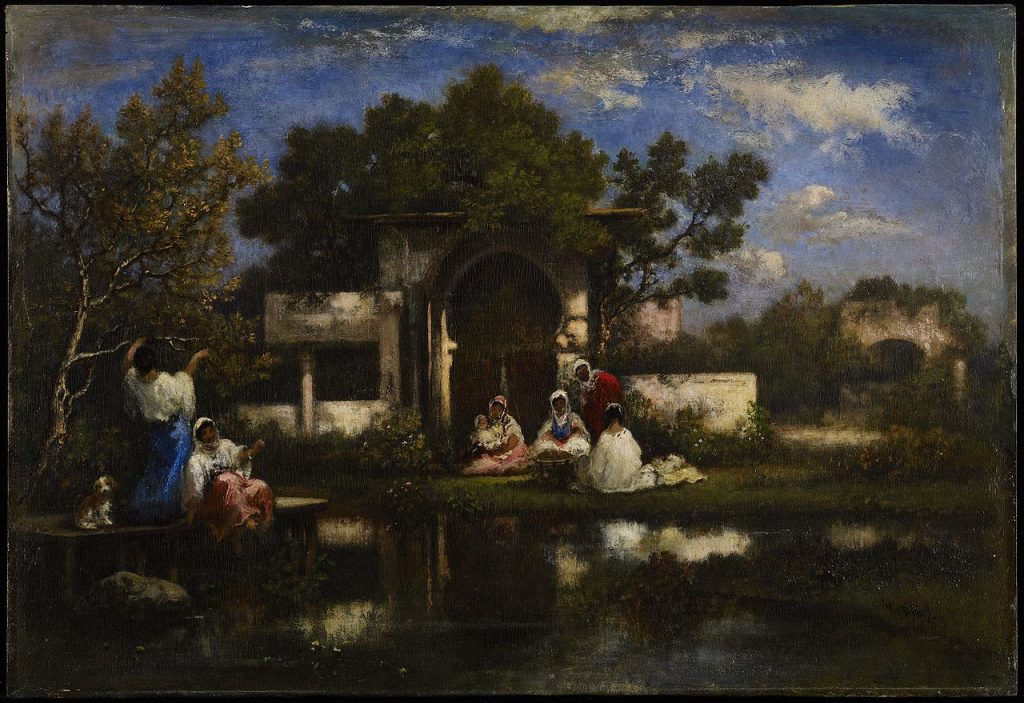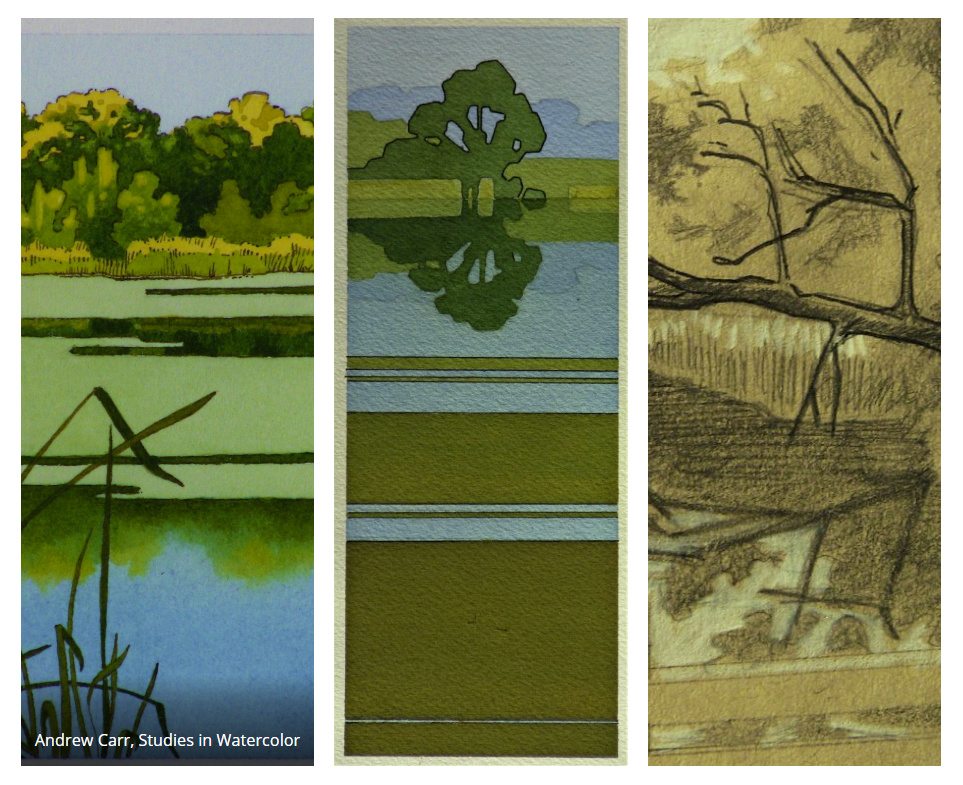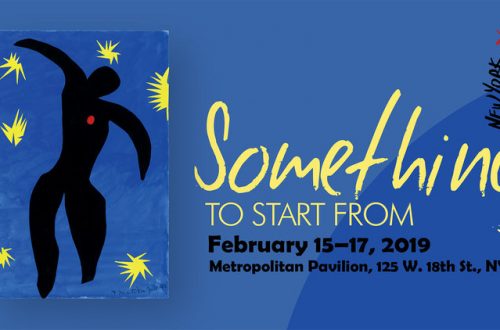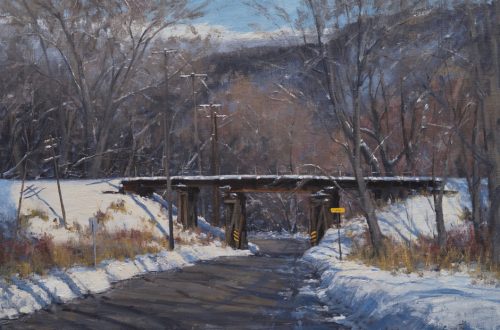by Andrew Carr
I want to describe a painting. It’s of a partially fallen tree, leaning out over still water. The painting is unfinished. In fact, apart from a handful of studies, it hasn’t even been started yet. For the moment it’s primarily an idea. I want to try and describe this idea because in its development, in trying to find solutions to its particular challenges, I’ve come to a better understanding of the artistic process.
About a year ago I moved into an apartment in West St. Paul and began accustoming myself to a new space, and a new neighborhood. I hung pictures on the empty walls, and got a local library card. I started learning street names, and where the best restaurants were. But the first place that I really began to feel at home was Thompson Pond, just a couple blocks away. Even before I’d finished walking around it for the first time, I was already thinking about painting its reflections, and the plants submerged underneath the water. I was hesitant, however, to dive in too quickly. I wanted to get to know the place before I tried to capture any of it. You can tell the difference, I think, between the way an artist paints a stranger, and the way he paints his own brother. So after moving in, I kept working on older paintings, going down to the pond whenever I needed a break, to take a walk, or to read a book out on the dock.
Even after I started making tentative studies—little watercolors of the lily-pads and algae—there was one place I continued to visit without trying to depict. A short ways along the path was a wooden bridge that stepped over a murky stream. The slow water passed underneath and then spread out into a passage among reeds, before opening up onto the pond. Not far from the bridge was a tree that had fallen. Still alive, it leaned out over the waterway between the reeds, reaching a branch down towards its own reflection without quite touching it. Whenever I went for a walk around the pond I would stop at the bridge for a while and look at this tree.
Each time that I returned it would show me something new. Each time I would bring my memory of the place with me, and each time I would leave with my vision slightly refined. I grew to love the way the tree reached towards itself in the unbroken, glassy surface of the water, like Caravaggio’s Narcissus. More than anything though, it reminded me of the sensation of riding in a canoe while other people paddle. The sensation of sitting for a long time in the hot sun and dangling your fingers just over the water so that with the slight rocking of the boat, your fingertips occasionally skim the cold, dark surface.
The idea for my piece began to take shape, and this sensation was at the heart of it. As I continued painting other reflections around the pond, however, I started to notice a sort of subtle optical illusion that kept showing up in my work. In the paintings that I had done, the surface of the water kept disappearing. Reflected shapes ended up looking like they were directly below the originals. I had noticed an effect like this before, in a painting by Narcisse-Virgile Diaz de la Peña at the Minneapolis Institute of Arts, where the reflection of the dark doorway in the center of the picture seems to be beneath the women sitting around on the shore, instead of out in front of them.

There was something beautiful and dreamlike about this. The reflections mirrored the world above in the way that roots mirror branches. Shorelines became islands, floating in the sky. I didn’t necessarily mind. Only, it started to pose a potential problem for the painting that I was imagining. Because so much of what I found compelling about the tree by the bridge was the sort of “touchability” of its reflection, that sensation of fingertips just above the water. My painting needed a sense of the surface of the water, so that the reflection would feel just out of reach—not far back, below and beneath.

It took me a while to recognize this problem for what it was: a good sign. A sign that I was starting to get to know the place. If there were problems, it was because I wasn’t a complete stranger anymore, and I understood that I couldn’t paint this tree in an arbitrary manner. I was beholden to it. A problem, I realized, meant that my work had meaning. A criterion for success was emerging, along with the possibility of failure. I now really wanted something, and even more importantly what I wanted had arisen out of patient dialogue with the place.
So I developed a solution. Imagine a map of the world hanging on your dining room wall. Now imagine taking it down and laying it on the dining room table. How does the map distort as you sit in your chair and look at it?
Systems of perspective tell us that the right and left-hand sides of the map should begin to lean towards each other, like the rails of a train-track receding into the distance. Except, on such a small scale, from the gentle perspective of where you’re sitting at the table, this distortion is hardly noticeable at all. What is noticeable, however, is the way the continents scrunch. That is to say, they get short and stout. As the map moves away from you, the vertical dimension of the continents diminishes rapidly, while the horizontal dimension stays more or less constant. In relatively shallow space, with a relatively gentle angle, this is one of the primary pieces of visual information that tells you a particular plane is receding.
And I realized that if I applied this distortion to the reflection of the tree it would visually affirm the plane of the water. I would scrunch the tree’s reflection like a continent on a map. I decided to do this, even though, in reality, the reflection was free of any such distortion. To put it another way—I decided that I needed to diverge from the literal appearance, to make reality more apparent. That decision may perhaps seem commonplace, or mostly technical. For me it was a moment of profound clarity. I had returned to this small place over and over. I had refrained from drawing it out of respect. I felt that with each visit we had gotten to know each other. And now I had decided to alter what I saw—not out of stylistic caprice or eccentricity, but out of a conscientious desire to describe what I had been shown. I felt that I understood the task of the artist in an entirely new and tangible way.
One day soon afterwards I was sick and stayed home from work. I slept in late and after having something to eat felt like I needed fresh air. So I took my sketchbook and went down to the pond. I had decided that I was ready to begin my piece. But when I got to the park, many of the trees had pink plastic bands stretched around their trunks. Even some of the dark, old oaks by the pavilion had been marked, and down by the water a whole grove of aspens had been wrapped up together. I continued along the path to where the bridge was. It too had a pink plastic ribbon, as did the tree I’d come to see. After looking for a while I began drawing, slowly and carefully, a little thrown by the pink ribbons, but savoring what I’d anticipated for so long, and wanting to do it right. As I was working, a man with a yellow safety vest and a hard hat came down the path, passed me and then stopped at the other end of the bridge. He began making notes on a clipboard. For a while we stood together like that, on either side of the bridge, looking and taking notes, me in my sketchbook and he on his clipboard. He finished and as he was passing by I stopped him and asked if the pink ribbons meant the trees would be cut down. He said he was afraid so. He said there was a buildup of toxic sediment at the bottom of the pond. Chemical runoff from neighboring yards and the nearby road had built up over time and needed to be dredged. I asked how long the project would take? About a year. When would they begin cutting the trees down? Tomorrow, he said.
I thanked him and he left and I stayed and sketched for several hours. I was feeling sick again, but I stood and drew for as long as I could, with as much precision and love as I could manage. When I drove past the park the next day the whole area had been bulldozed and I didn’t feel like stopping. That weekend, as I described the scene to a friend, I was surprised to find myself on the verge of tears.
I have still not started painting.

Andrew Carr is a writer, painter, and teacher from St. Paul, MN. He loves cinema, short stories, and Saturday night jazz. He creates in the hope that his work might be as natural “As the cackle of toucans/ In the place of toucans.” You can find more of his drawing and painting at andrewgrumcarr.com.
Header Image: photo of Thompson Pond by the author.






4 Comments
Eliot Grasso
Hi Andrew,
I’m a musician and tutor at Gutenberg College where I teach on music and the Great Books.
I read your article “On Thompson Pond” in the Veritas Journal with great interest. One particular idea struck me: the tactile sensation involved in translating reality into painting. What I found interesting about this idea is that paintings are usually created with the expectation that people should not touch them. Certainly, there are exceptions, but this seems to be a general cultural rule.
Your wrote: “The sensation of sitting for a long time in the hot sun and dangling your fingers just over the water so that with the slight rocking of the boat, your fingertips occasionally skim the cold, dark surface.” and later: “Because so much of what I found compelling about the tree by the bridge was the sort of “touchability” of its reflection, that sensation of fingertips just above the water.”
Do you find yourself wanting your audience to be drawn to actually touch your paintings?
Just some musings on my part. I’d love to hear your thoughts when or if you have time.
Best,
Eliot
Andrew Carr
Thanks for your interest Eliot, and for your thoughts.
I can think of at least one friend of mine for whom the urge to touch paintings consistently proves irresistible. I sometimes find myself wanting to touch sculpture—small statues in particular, to hold them and feel how they fit into my hand. When interacting with art, the other senses do usually seem relegated to living vicariously through sight. And at times touch in particular seems like it wants to live for itself.
For me the desire to actually touch a painting is counterbalanced by some sort of desire not to “disturb” the painting. I feel this in front of certain oil paintings, especially when the artist has painted in such a way as to hide their brush strokes and maintain an almost perfectly smooth surface.
(This Whistler comes to mind: https://i.pinimg.com/originals/ef/ee/cf/efeecf16ccc7733d050f5aa805def2a3.jpg or this portrait by Eugene Carriere: https://cdn2.oceansbridge.com/2018/06/04125327/Gustave-Geffroy-Eugene-Carriere-Oil-Painting.jpg ).
Paintings like these, at times, take on the quality of a still pool. And, as with a still pool, I want to touch the water and see the clarity of the ripples as they expand out, and at the same time I don’t want to interfere or disturb the peace of such a beautiful moment. (Perhaps Basho’s famous Frog Haiku is so celebrated in part because he manages to have it both ways).
These scenes create a conflict within me, but it’s a pleasant conflict. It’s the same feeling I get when I’m sitting with a friend and suddenly I realize how beautiful they look, sitting just so, just as they are. And part of me wants to tell them, and another part of me knows better, knows to simply savor the moment without trying to grasp or capture it, knows that the “untouchable” or “unspeakable” quality to the moment is actually essential to its beauty.
One other image that maybe has a valuable connection here: a bathroom mirror fogged over with steam. The desire on the one had to draw with your fingertip, to puncture through to the clear mirror underneath. On the other hand the appreciation for the unbroken glaze of condensation, like the vision in the morning of freshly fallen snow, and the knowledge that to touch means to leave streaks and fingerprints.
Best,
Andrew
Rebecca Coleman
Andrew,
First off, thanks for writing this article. I so appreciate reading about what struck someone in everyday life and the details surrounding that experience. Paying close attention to the intricacies of life is something I constantly am trying to make myself slow down and do. I’m not much of an artist, but it is something I think everyone should strive more to do, not just people who translate their observations onto a canvas or sketchbook.
Secondly, have you read the book, “The Picture of Dorian Gray”? l think you have captured a bit of what this whole book is about in your article. A very interesting read and your article is a great spring board to a great conversation.
Thanks for the food for thought.
Blessings,
Becca
Pingback: